#nuclear anti-satellite weapon
Text
Putin Using Nuclear Weapons in Space?
In the latest episode of “Lest We Forget-Historical,” host Lillian Cauldwell delves into the rumors surrounding Russian President Vladimir Putin’s alleged development of a nuclear anti-satellite weapon in space. According to CNN, this weapon, akin to an electromagnetic pulse (EMP), poses a significant threat to both government and commercial satellite operations for the United States and its…
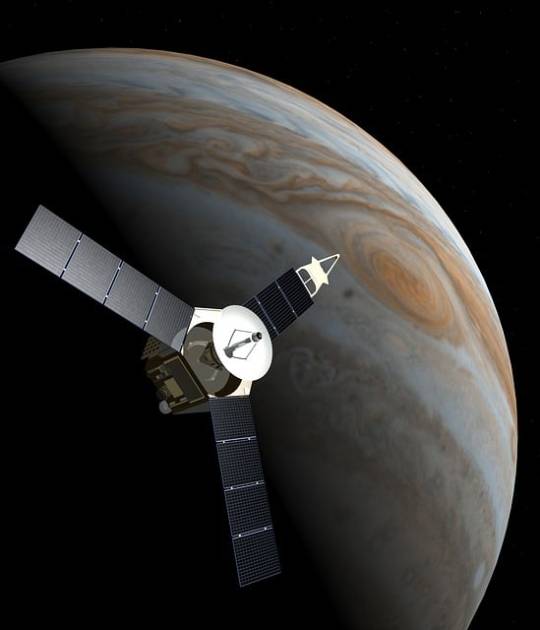
View On WordPress
#1967 Space Treaty#CNN#Lillian Cauldwell#News#nuclear anti-satellite weapon#Nuclear Weapons#Russian President Vladimir Putin#Spy&039;s
2 notes
·
View notes
Text
Russia vetoed a United Nations resolution that was aimed at preventing a nuclear arms race in space.
The resolution was sponsored by the United States and Japan and called upon all nations to never deploy nuclear weapons in outer space. The resolution comes on the heels of recent reports that Russia is developing a nuclear anti-satellite weapon of some kind. The furor caused by the reports led the White House to issue a statement that the rumored weapon poses "no immediate threat to anyone's safety."
Thirteen nations, including the United States, voted in favor of the resolution. Russia was the only vote against, while China abstained, meaning it did not vote one way or the other. Russia's ambassador to the U.N., Vassily Nebenzia, called the resolution a "dirty spectacle" and a "cynical ploy," according to the Associated Press.
Continue Reading.
17 notes
·
View notes
Text

LETTERS FROM AN AMERICAN
December 26, 2023
HEATHER COX RICHARDSON
DEC 27, 2023
On December 26, 1991, the New York Times ran a banner headline: “Gorbachev, Last Soviet Leader, Resigns; U.S. Recognizes Republics’ Independence.” On December 25, Soviet president Mikhail Gorbachev had resigned, marking the end of the Union of Soviet Socialist Republics, often referred to as the Soviet Union or USSR.
Former Soviet republics had begun declaring their independence in March 1990, the Warsaw Pact linking the USSR’s Eastern European satellites into a defense treaty dissolved by July 1991, and by December 1991 the movement had gathered enough power that Belarus, Russia, and Ukraine joined together in a “union treaty” as their leaders announced they were creating a new Commonwealth of Independent States. When almost all the other Soviet republics announced on December 21 that they were joining the new alliance, Gorbachev could either try to hold the USSR together by force or step down. He chose to step down, handing power to the president of the Russian Federation, Boris Yeltsin.
The dissolution of the USSR meant the end of the Cold War, and those Americans who had come to define the world as a fight between the dark forces of communism and the good forces of capitalism believed their ideology had triumphed. Two years ago, Gorbachev said that with the collapse of the Soviet Union, "They grew arrogant and self-confident. They declared victory in the Cold War."
The collapse of the USSR gave the branch of the Republican Party that wanted to destroy the New Deal confidence that their ideology was right. Believing that their ideology of radical individualism had destroyed the USSR, these so-called Movement Conservatives very deliberately set out to destroy what they saw as Soviet-like socialist ideology at home. As anti-tax crusader Grover Norquist wrote in the Wall Street Journal: “For 40 years conservatives fought a two-front battle against statism, against the Soviet empire abroad and the American left at home. Now the Soviet Union is gone and conservatives can redeploy. And this time, the other team doesn't have nuclear weapons.”
In the 1990s the Movement Conservatives turned their firepower on those they considered insufficiently committed to free enterprise, including traditional Republicans who agreed with Democrats that the government should regulate the economy, provide a basic social safety net, and promote infrastructure. Movement Conservatives called these traditional Republicans “Republicans in Name Only” or RINOs and said that, along with Democrats, such RINOs were bringing “socialism” to America.
With the “evil empire,” as President Ronald Reagan had dubbed the Soviet Union, no longer a viable enemy, Movement Conservatives, aided by new talk radio hosts, increasingly demonized their domestic political opponents. As they strengthened their hold on the Republican Party, Movement Conservatives cut taxes, slashed the social safety net, and deregulated the economy.
At the same time, the oligarchs who rose to power in the former Soviet republics looked to park their illicit money in western democracies, where the rule of law would protect their investments. Once invested in the United States, they favored the Republicans who focused on the protection of wealth rather than social services. For their part, Republican politicians focused on spreading capitalism rather than democracy, arguing that the two went hand in hand.
The financial deregulation that made the U.S. a good bet for oligarchs to launder money got a boost when, shortly after the September 11, 2001, attacks, Congress passed the PATRIOT Act to address the threat of terrorism. The law took on money laundering and the illicit funding of terrorism, requiring financial institutions to inspect large sums of money passing through them. But the Financial Crimes Enforcement Network (FinCEN) exempted many real estate deals from the new regulations.
The United States became one of the money-laundering capitals of the world, with hundreds of billions of dollars laundered in the U.S. every year.
In 2011 the international movement of illicit money led then–FBI director Robert Mueller to tell the Citizens Crime Commission of New York City that globalization and technology had changed the nature of organized crime. International enterprises, he said, “are running multi-national, multi-billion dollar schemes from start to finish…. They may be former members of nation-state governments, security services, or the military…. These criminal enterprises are making billions of dollars from human trafficking, health care fraud, computer intrusions, and copyright infringement. They are cornering the market on natural gas, oil, and precious metals, and selling to the highest bidder…. These groups may infiltrate our businesses. They may provide logistical support to hostile foreign powers. They may try to manipulate those at the highest levels of government. Indeed, these so-called ‘iron triangles’ of organized criminals, corrupt government officials, and business leaders pose a significant national security threat.”
In 2021, Congress addressed this threat by including the Corporate Transparency Act in the National Defense Authorization Act. It undercut shell companies and money laundering by requiring the owners of any company that is not otherwise overseen by the federal government (by filing taxes, for example, or through close regulation) to file with FinCEN a report identifying (by name, birth date, address, and an identifying number) each person associated with the company who either owns 25% or more of it or exercised substantial control over it. The measure also increased penalties for money laundering and streamlined cooperation between banks and foreign law enforcement authorities.
But that act wouldn’t take effect for another three years.
Meanwhile, once in office, the Biden administration made fighting corruption a centerpiece of its attempt to shore up democracy both at home and abroad. In June 2021, Biden declared the fight against corruption a core U.S. national security interest. “Corruption threatens United States national security, economic equity, global anti-poverty and development efforts, and democracy itself,” he wrote. “But by effectively preventing and countering corruption and demonstrating the advantages of transparent and accountable governance, we can secure a critical advantage for the United States and other democracies.”
In March 2023 the Treasury told Congress that “[m]oney laundering perpetrated by the Government of the Russian Federation (GOR), Russian [state-owned enterprises], Russian organized crime, and Russian elites poses a significant threat to the national security of the United States and the integrity of the international financial system,” and it outlined the ways in which it had been trying to combat that corruption. “In light of Russia’s further invasion of Ukraine,” it said, “we must redouble our efforts to prevent Russia from abusing the U.S. financial system to sustain its war and counter Russian sanctioned individuals and firms seeking to exploit vulnerabilities in the U.S. financial system.”
The collapse of the USSR helped to undermine the Cold War democracy that opposed it. In the past 32 years we have torn ourselves apart as politicians adhering to an extreme ideology demonized their opponents. That demonization also helped to justify the deregulation of our economy and then the illicit money from the rising oligarchs it attracted, money that has corrupted our democratic system.
But there are at least signs that the financial free-for-all might be changing. The three years are up, and the Corporate Transparency Act will take effect on January 1, 2024.
LETTERS FROM AN AMERICAN
HEATHER COX RICHARDSON
#Heather Cox Richardson#Letters from an American#money laundering#the former Soviet Union#financial deregulation#movement conservatives#Corporate Transparency Act#corruption#history#the hard right
11 notes
·
View notes
Text
Russia vetoed a United Nations Security Council resolution Wednesday that would have reaffirmed a nearly 50-year-old ban on placing weapons of mass destruction into orbit, two months after reports Russia has plans to do just that.
Russia's vote against the resolution was no surprise. As one of the five permanent members of the Security Council, Russia has veto power over any resolution that comes before the body. China abstained from the vote, and 13 other members of the Security Council voted in favor of the resolution.
If it passed, the resolution would have affirmed a binding obligation in Article IV of the 1967 Outer Space Treaty, which says nations are "not to place in orbit around the Earth any objects carrying nuclear weapons or any other kinds of weapons of mass destruction."
Going Nuclear
Russia is one of 115 parties to the Outer Space Treaty. The Security Council vote Wednesday follows reports in February that Russia is developing a nuclear anti-satellite weapon.
"The United States assesses that Russia is developing a new satellite carrying a nuclear device," said Jake Sullivan, President Biden's national security advisor. "We have heard President Putin say publicly that Russia has no intention of deploying nuclear weapons in space. If that were the case, Russia would not have vetoed this resolution."
The United States and Japan proposed the joint resolution, which also called on nations not to develop nuclear weapons or any other weapons of mass destruction designed to be placed into orbit around the Earth. In a statement, US and Japanese diplomats highlighted the danger of a nuclear detonation in space. Such an event would have "grave implications for sustainable development, and other aspects of international peace and security," US officials said in a press release.
With its abstention from the vote, "China has shown that it would rather defend Russia as its junior partner, than safeguard the global nonproliferation regime," said Linda Thomas-Greenfield, the US ambassador to the UN.
US government officials have not offered details about the exact nature of the anti-satellite weapon they say Russia is developing. A nuclear explosion in orbit would destroy numerous satellites—from many countries—and endanger astronauts. Space debris created from a nuclear detonation could clutter orbital traffic lanes needed for future spacecraft.
The Soviet Union launched more than 30 military satellites powered by nuclear reactors. Russia's military space program languished in the first couple of decades after the fall of the Soviet Union, and US intelligence officials say it still lags behind the capabilities possessed by the US Space Force and the Chinese military.
Russia's military funding has largely gone toward the war in Ukraine for the last two years, but Putin and other top Russian officials have raised threats of nuclear force and attacks on space assets against adversaries. Russia's military launched a cyberattack against a commercial satellite communications network when it invaded Ukraine in 2022.
Russia has long had an appetite for anti-satellite (ASAT) weapons. The Soviet Union experimented with "co-orbital" ASATs in the 1960s and 1970s. When deployed, these co-orbital ASATs would have attacked enemy satellites by approaching them and detonating explosives or using a grappling arm to move the target out of orbit.
In 1987, the Soviet Union launched an experimental weapons platform into orbit to test laser technologies that could be used against enemy satellites. Russia shot down one of its own satellites in 2021 in a widely condemned "direct ascent" ASAT test. This Russian direct ascent ASAT test followed demonstrations of similar capability by China, the United States, and India. Russia's military has also demonstrated satellites over the last decade that could grapple onto an adversary's spacecraft in orbit, or fire a projectile to take out an enemy satellite.
These ASAT capabilities could destroy or disable one enemy satellite at a time. The US Space Force is getting around this threat by launching large constellations of small satellites to augment the military's much larger legacy communications, surveillance, and missile warning spacecraft. A nuclear ASAT weapon could threaten an entire constellation or render some of space inaccessible due to space debris.
Russia's ambassador to the UN, Vasily Nebenzya, called this week's UN resolution "an unscrupulous play of the United States" and a "cynical forgery and deception." Russia and China proposed an amendment to the resolution that would have banned all weapons in space. This amendment got the support of about half of the Security Council but did not pass.
Outside the 15-member Security Council, the original resolution proposed by the United States and Japan won the support of more than 60 nations as co-sponsors.
"Regrettably, one permanent member decided to silence the critical message we wanted to send to the present and future people of the world: Outer space must remain a domain of peace, free of weapons of mass destruction, including nuclear weapons," said Kazuyuki Yamazaki, Japan's ambassador to the UN.
5 notes
·
View notes
Text
Russia-Ukraine Daily Briefing
🇷🇺 🇺🇦 Friday Briefing:
☢️ Russia to move toward revoking ratification of nuclear test ban treaty
----------------------------------------------------------------------
- Russian missile strike on Ukraine village kills 51 during memorial to fallen soldier
- Biden team weighs using State Department grants to fund weapons for Ukraine
- Germany to boost Ukraine air defense with second Patriot system
- US and EU need legal frameworks to seize Russian assets: Blinken
- NATO to bring more anti-drone systems to Romania
- Chinese firm sold satellites for intelligence to Russia's Wagner
- German police raid properties of Russian oligarch Usmanov
- Number of Russian soldiers tried for murder surges in 2023
- Russia plans naval base in Abkhazia, triggering criticism from Georgia
- Rheinmetall supplies Ukraine with more drone reconnaissance systems
📨 More news in a daily newsletter: https://russia-ukraine-newsletter.beehiiv.com/subscribe
💬 Keep up with me on X: https://twitter.com/rvps2001
or Mastodon: https://mastodon.social/@rvps2001

#russia ukraine war#ukraine russia war#ukraine war#russian army#russian war crimes#news#newsletter#russia#ukraine
6 notes
·
View notes
Text
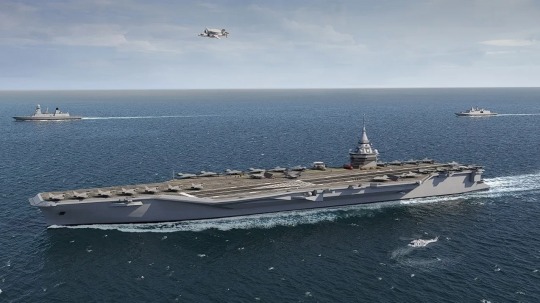
Updated project of the latest French aircraft carrier PANG is released
Fernando Valduga By Fernando Valduga 10/19/22 - 11:00 in Military
An updated project of the future aircraft carrier of the French Navy PANG (porte-avions de nouvelle génération) was presented by the manufacturers at Euronaval 2022 underway in France.

French President Emmanuel Macron officially gave the green light to the construction of the new nuclear-powered aircraft carrier as part of the PA-Ng program in December 2020. The future flagship of the Marine Nationale (French Navy) intends to replace the existing Charles de Gaulle around 2038.
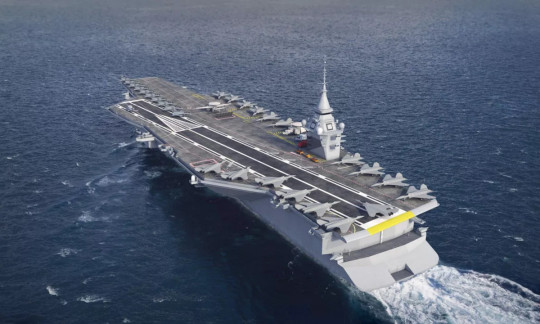
The previous design revealed in 2020 showed the aircraft carrier in the form of a "waterdrop", while the model displayed on the Euronaval looks more like a "square". It also has the SeaFire radar in the configuration of four fixed panels; the "cone" at the top of the island (Command Center for operations on the flight deck, as well as the ship as a whole) went to give way to a series of domes for satellite communication. There is now a helicopter point behind the island, as well as the area to perform aircraft maintenance on the flight deck.

After construction, the PANG aircraft carrier ~310m in length could move about 75,000 tons. It will have two or three 90m electromagnetic catapults (EMALS) from General Atomics of the USA.
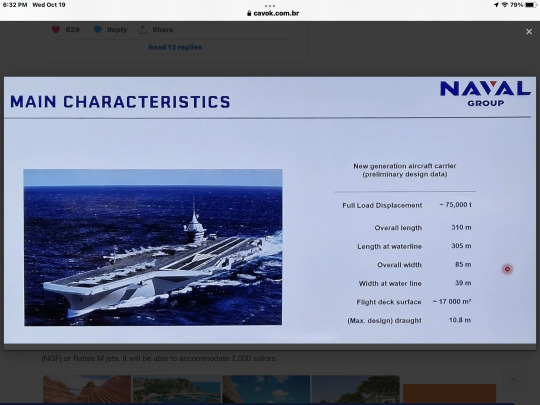
The aircraft carrier will have a maximum speed of 30 knots and will be able to carry approximately 30 Next Generation Fighter (NGF) or Rafale M jets. It will be able to accommodate 2,000 sailors.

The PANG scale model now features several short-range anti-aircraft self-defense systems SIMBAD-RC, RapidFire CIWS, VLS for Aster missiles and the new CMLS anti-torpedo decoy launchers.
Tags: EuronavalMarine Nationale / French NavyPANG - Porte Avion Nouvelle Générationaircraft carriers
Previous news
Some Boeing documents for 737 MAX 7 certification are incomplete, need to be reassessed, says FAA
Next news
VIDEO: Portugal presents the Air Force's first KC-390 aircraft
Fernando Valduga
Fernando Valduga
Aviation photographer and pilot since 1992, he has participated in several events and air operations, such as Cruzex, AirVenture, Dayton Airshow and FIDAE. It has works published in specialized aviation magazines in Brazil and abroad. Uses Canon equipment during his photographic work in the world of aviation.
Related news
ARMAMENTS
Chinese advances can put hypersonic weapons on aircraft carriers
15/10/2022 - 21:31
BRAZIL
Brazilian Navy releases official note on return of NAe São Paulo hull to Brazil
08/10/2022 - 16:05
MILITARY
Aircraft carrier USS Gerald R. Ford (CVN-78), the world's largest warship, is ready for deployment
28/09/2022 - 11:00
MILITARY
US and South Korea start first joint exercise with an aircraft carrier in 5 years
26/09/2022 - 17:00
HELICOPTERS
IMAGES: French Navy receives the first H160 for search and rescue missions
22/09/2022 - 20:13
Portrayed in service with the Brazilian Navy, São Paulo was to be dismantled in Turkey. (Photo: Alcluiz / Wikimedia Commons)
BRAZILIAN NAVY
After being banned from entering Turkey, aircraft carriers São Paulo is returning to Brazil
08/09/2022 - 08:39
home Main Page Editorials INFORMATION events Cooperate Specialities advertise about
Cavok Brazil - Digital Tchê Web Creation
Commercial
Executive
Helicopters
HISTORY
Military
Brazilian Air Force
Space
Specialities
Cavok Brazil - Digital Tchê Web Creation
5 notes
·
View notes
Link
0 notes
Text
Pentagon official warns Russian anti-satellite nuclear weapon could be devastating
The reapl problem is, they're not happy that Russia has developed it or is developing it before us. They are. Just imagine there could be no more hungry in the world if we weren't so military driven. And for resources, that's what all this is really about
0 notes
Text
Russia, US clash at UN over nuclear weapons in space
By Michelle Nichols, April 25, 2024
UNITED NATIONS, April 24 (Reuters) – Russia on Wednesday vetoed a U.S.-drafted United Nations Security Council resolution that called on countries to prevent an arms race in outer space, a move that prompted the United States to question if Moscow was hiding something.
The vote came after Washington accused Moscow of developing a anti-satellite nuclear weapon…

View On WordPress
0 notes
Text
BBC 0429 25 Apr 2024
12095Khz 0358 25 APR 2024 - BBC (UNITED KINGDOM) in ENGLISH from TALATA VOLONONDRY. SINPO = 55344. English, dead carrier s/on @0358z with ID@0359z pips and Newsday preview. @0401z World News anchored by Chris Berrow. The leader of the US House of Representatives was heckled in a tense visit to Columbia University as protests against the war in Gaza continue to spread across US campuses.Republican House Speaker Mike Johnson said Columbia officials had lost control of the situation. In Texas and California, police confronted campus protesters and made dozens of arrests. Pope Francis continues to be in contact, every day, with the Catholic community at Gaza’s Church of the Holy Family, that is currently offering shelter to some 700 Palestinians who have lost their homes in the current war between Hamas and Israel. A formal ceremony to install Haiti's transitional ruling council will be held early Thursday, the prime minister's office said, as the violence-wracked nation moves to form an interim government. The event will be held at the prime minister's office, known as Villa d'Accueil, in the Musseau neighborhood of the capital, instead of the presidential palace which is still under attack from gangs. Venezuelan opposition candidate Edmundo Gonzalez said on Wednesday he is committed to carrying out a transition that will allow exiled people to return to the country and political prisoners to be freed. Though Maduro's government agreed to a prisoner swap deal with the U.S. in December, freeing dozens of Venezuelans as well as some Americans, opposition members and activists recently have been detained for what supporters say are unfounded reasons. U.S. Secretary of State Antony Blinken on Thursday called on China to provide a level playing field for American businesses as he began a visit aimed at resolving a raft of contentious issues that could jeopardise the newly repaired relationship. Blinken's trip is the latest high-level contact between the two nations that, along with working groups on issues from global trade to military communication, have tempered the public acrimony that drove relations to historic lows early last year. Ukraine for the first time has begun using long-range ballistic missiles provided secretly by the United States, bombing a Russian military airfield in Crimea last week and Russian forces in another occupied area overnight, American officials said Wednesday. Long sought by Ukrainian leaders, the new missiles give Ukraine nearly double the striking distance, up to 300 kilometers (190 miles), that it had with the mid-range version of the weapon that it received from the U.S. last October. Russia on Wednesday vetoed a U.S.-drafted United Nations Security Council resolution that called on countries to prevent an arms race in outer space, a move that prompted the United States to question if Moscow was hiding something. The vote came after Washington accused Moscow of developing a anti-satellite nuclear weapon to put in space, an allegation that Russia has denied. Russian President Vladimir Putin has said that Moscow was against putting nuclear weapons in space. Australian police have arrested seven teenagers as part of a wave of counter-terrorism raids across Sydney, claiming it was "likely" the youths may have been plotting an attack. The suspects are believed to share a "religiously motivated violent extremist ideology", say police. The raids are linked to last week's stabbing of an Assyrian bishop, which police declared a "terrorist act". Police say the offenders were "juveniles" aged from 15 to 17. @0405z "Newsday" begins. 250ft unterminated BoG antenna pointed E/W w/MFJ-1020C active antenna (used as a preamplifier/preselector), Etón e1XM. 250kW, beamAz 315°, bearing 63° . Received at Plymouth, MN, United States, 15359KM from transmitter at Talata Volonondry. Local time: 2258.
1 note
·
View note
Text
Ukraine-Russia war latest: Russia warns Finland it is risking 'military incident' - as major US weapons shipment could be sent to Ukraine this week | World News
New Post has been published on https://petn.ws/pnCwi
Ukraine-Russia war latest: Russia warns Finland it is risking 'military incident' - as major US weapons shipment could be sent to Ukraine this week | World News
Russia is set to square off with the US at the UN later today over nuclear weapons in space, with a vote due on a resolution calling on countries to prevent a new arms race. Some diplomats expect Russia to block the US-drafted resolution, which comes after Washington accused Moscow of developing an anti-satellite nuclear […]
See full article at https://petn.ws/pnCwi
#OtherNews
0 notes
Photo
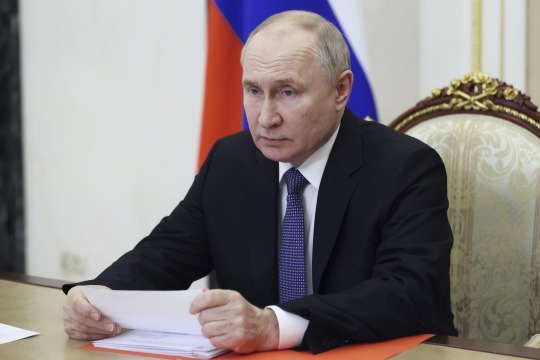
US talks with Russia to discourage space anti-satellite nuclear weapons ongoing
0 notes
Text
The Revolutionary Power Of Directed Energy Weapons

Source – LOCKHEED MARTIN
In the realm of military technology, the landscape is constantly evolving. From the advent of gunpowder to the development of nuclear weapons, humanity’s ingenuity has shaped the way wars are fought and won. Among the latest advancements in this field, directed energy weapons (DEWs) stand out as a transformative force with the potential to redefine the nature of modern warfare. This article explores the concept of DEWs, their applications, implications, and the future they may herald.
Understanding Directed Energy Weapons
DEW encompasses a diverse array of technologies that emit focused energy in the form of lasers, microwaves, or particle beams. Unlike conventional munitions that rely on physical projectiles, DEWs deliver energy at the speed of light, making them incredibly fast and accurate. This characteristic enables precise targeting of enemy assets with minimal collateral damage, a capability that distinguishes DEWs from traditional weaponry.
Applications of DEW:
The versatility of DEWs renders them suitable for various military applications across land, air, sea, and space domains. One primary application is in missile defense, where high-energy lasers can intercept and destroy incoming ballistic threats with unparalleled speed and precision. Additionally, DEWs can be employed for target designation, disabling enemy electronics, and neutralizing hostile drones or unmanned aerial vehicles (UAVs).
On the battlefield, ground-based DEW systems offer an effective means of engaging enemy forces, vehicles, and infrastructure. Mounted on platforms such as trucks or armored vehicles, these weapons provide soldiers with a potent tool for engaging threats at extended ranges while minimizing the logistical burden associated with conventional ammunition.
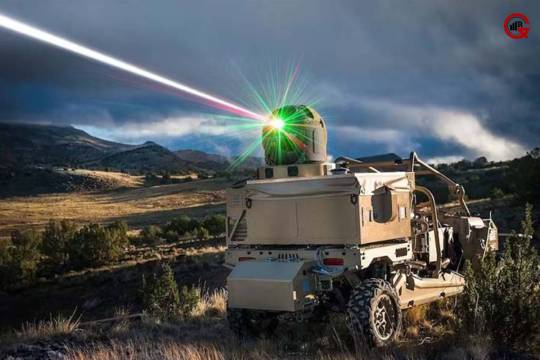
In the maritime domain, DEWs hold the potential to revolutionize naval warfare by offering a cost-effective means of defending against anti-ship missiles, small boats, and unmanned underwater vehicles (UUVs). Moreover, DEWs can be integrated into shipboard defense systems, enhancing the survivability of naval vessels against modern threats.
In space, DEWs have the capability to safeguard critical assets such as satellites from adversarial attacks. By deploying orbital platforms armed with directed energy weapons, nations can deter aggression and protect their space-based infrastructure from hostile actions.
Implications and Challenges
Despite their promising potential, the widespread adoption of DEW presents several challenges and implications. One concern relates to the development of effective countermeasures by adversaries, which could potentially mitigate the effectiveness of DEWs on the battlefield. Moreover, the high energy requirements and thermal management issues associated with these weapons necessitate significant advancements in power generation and heat dissipation technologies.
Furthermore, the ethical and legal considerations surrounding the use of DEWs raise important questions regarding their proportionality, discrimination, and adherence to international humanitarian law. Ensuring that DEWs are employed in a manner consistent with ethical norms and legal frameworks will be essential to mitigate the risks of unintended harm and civilian casualties.
From a strategic standpoint, the proliferation of directed energy weapons could disrupt existing military balances and escalate arms races among nations seeking to maintain a competitive edge. As such, policymakers must carefully assess the implications of deploying DEWs and consider measures to promote transparency, confidence-building, and arms control in this emerging domain.
The Future of Directed Energy Weapons
Looking ahead, the continued advancement and proliferation of DEW are poised to reshape the landscape of modern warfare. As research and development efforts progress, DEWs are likely to become more compact, efficient, and cost-effective, enabling their widespread deployment across military platforms.

Moreover, synergistic integration with other emerging technologies such as artificial intelligence (AI), autonomous systems, and advanced sensors will enhance the capabilities and effectiveness of DEWs on the battlefield. By leveraging these synergies, military forces can achieve unprecedented levels of situational awareness, precision targeting, and operational flexibility.
Beyond the battlefield, DEW holds the potential to revolutionize civilian applications ranging from aerospace propulsion and industrial manufacturing to homeland security and disaster response. By harnessing the power of directed energy, humanity can unlock new frontiers of innovation and address pressing challenges in the realms of energy, transportation, and environmental sustainability.
Advancements in DEW
Continuing advancements in directed (DEWs) are driving innovation and pushing the boundaries of what is possible on the battlefield and beyond. One area of focus is the development of more compact and portable DEW systems that can be integrated into a wider range of military platforms, including ground vehicles, aircraft, and individual soldier equipment. Miniaturization efforts aim to enhance mobility and versatility while maintaining the destructive power and precision of larger DEW platforms.
Additionally, researchers are exploring new materials and manufacturing techniques to improve the efficiency and reliability of DEW components. From high-powered laser diodes to advanced optics and cooling systems, these innovations are critical for maximizing the effectiveness and operational lifespan of directed energy weapons in harsh and demanding environments.
In the realm of power generation, efforts are underway to harness renewable energy sources such as solar, wind, and hydrogen fuel cells to sustainably power DEW systems. By reducing reliance on conventional fossil fuels and minimizing logistical burdens, renewable energy technologies offer a promising pathway toward enhancing the operational sustainability and environmental friendliness of directed energy weapons.
Moreover, advancements in beam control and targeting algorithms are enabling DEW operators to engage moving targets with unprecedented accuracy and speed. By leveraging real-time sensor data and predictive analytics, DEW systems can dynamically adjust their aim and optimize energy delivery for maximum effect, even in challenging and dynamic combat scenarios.
Emerging Trends and Future Challenges
Looking ahead, several emerging trends and challenges are poised to shape the evolution of directed energy weapons and their applications. One such trend is the integration of DEWs into multi-domain operations, where synchronized efforts across land, air, sea, space, and cyberspace domains enable synergistic effects and strategic advantage. By leveraging DEWs alongside traditional kinetic weapons, electronic warfare capabilities, and information operations, military forces can achieve greater operational agility and lethality against sophisticated adversaries.

However, as DEW technologies continue to mature and proliferate, concerns regarding arms control, proliferation, and escalation dynamics are likely to become increasingly prominent. The absence of clear international norms and agreements governing the development and use of directed energy weapons raises the risk of unintended consequences and strategic instability. Addressing these challenges will require proactive diplomacy, confidence-building measures, and transparent dialogue among nations to foster trust and mitigate the risks of miscalculation or conflict escalation.
Moreover, the rise of asymmetric threats and non-state actors armed with improvised DEW capabilities poses new challenges for defense planners and policymakers. From rogue states to terrorist organizations, the diffusion of DEW technologies to non-traditional actors could amplify existing security risks and undermine traditional deterrence strategies. As such, efforts to prevent the illicit proliferation of DEWs and strengthen international cooperation on arms control and non-proliferation will be essential to safeguard global security and stability.
Conclusion
Directed energy weapons represent a paradigm shift in military technology with far-reaching implications for the future of warfare. While their widespread adoption poses challenges and uncertainties, the transformative potential of DEWs offers new opportunities to enhance security, protect critical infrastructure, and advance human civilization. As nations navigate the complexities of this emerging domain, collaboration, dialogue, and responsible stewardship will be essential to harness the promise of directed energy weapons for the benefit of all humanity.
0 notes
Text
Last month, there was a sudden panic in the United States when House Intelligence Chairman Mike Turner issued a statement warning of a “serious national security threat” and demanded that President Biden declassify related information. The American media subsequently reported that Turner was referring to alleged Russian plans to deploy nuclear weapons in space, though U.S. National Security Council Spokesperson John Kirby later clarified that the matter concerns anti-satellite weapons that cannot be used to attack people or to strike targets on Earth. He explained that Russia’s development of the technology is concerning but does not pose an immediate threat.
To make sense of these reports and to respond to the panic that this situation provokes, The Naked Pravda welcomes back nuclear arms expert Pavel Podvig, a senior researcher at the U.N. Institute for Disarmament Research.
Timestamps for this episode:
(3:20) The (im)practicality of nuclear weapons in space
(5:31) Imagining a nuclear blast in orbit
(9:59) The feasibility of nuclear-powered space weapons
(28:02) The 1967 Outer Space Treaty and its modern-day implications
(31:26) Common misconceptions about space in movies
1 note
·
View note
Text
0 notes
